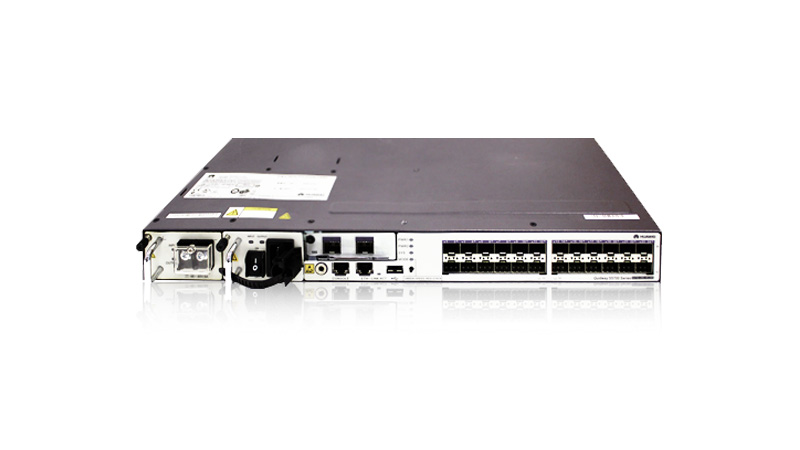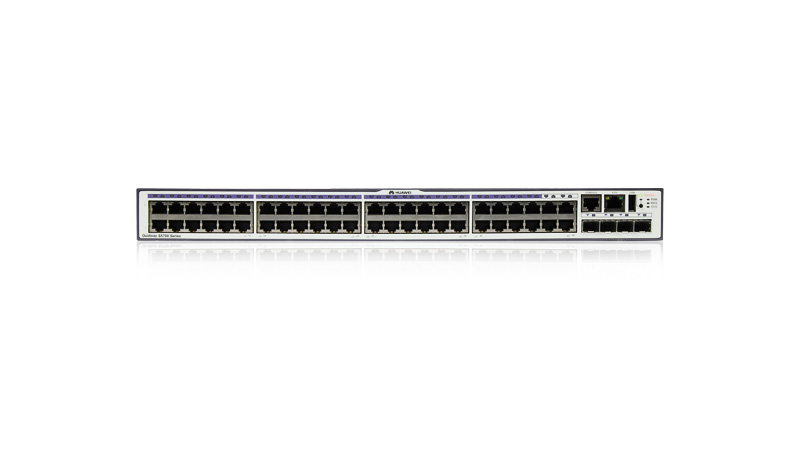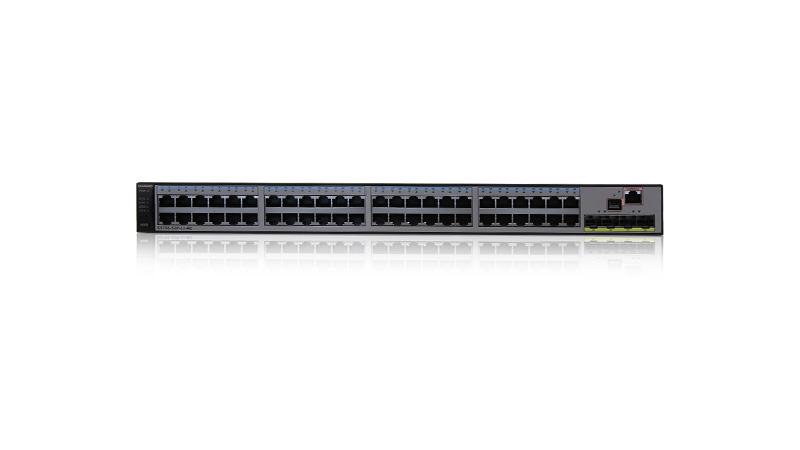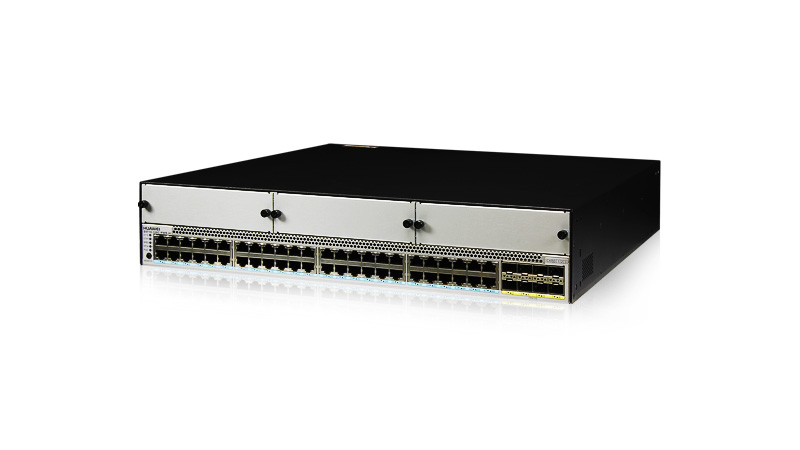Switch empresariales gigabit de la serie S5700
Los switch empresariales gigabit de la serie S5700 (S5700 de forma abreviada) son switch de próxima generación que ahorran energía y están desarrollados por Huawei para satisfacer la demanda de acceso a un gran ancho de banda y a la agregación de múltiples servicios Ethernet. Basado en un hardware de vanguardia y en el software de la Plataforma de Enrutamiento Versátil (VRP) de Huawei, el S5700 cuenta con una amplia capacidad de conmutación y puertos GE de alta densidad para implementar transmisiones upstream de 10 Gbit/s. El S5700 se puede utilizar en diversos escenarios de redes empresariales. Por ejemplo, puede funcionar como switch de acceso o de agregación en una red de área de campus, como switch de acceso gigabit en un Centro de Datos de Internet (IDC) y como switch de escritorio para ofrecer acceso de 1000 Mbit/s a terminales.
● Ranura de alimentación dual
● Apilamiento inteligente (iStack)
● BFD de hardware, OAM Ethernet de hardware
● Netstream
● Ethernet de consumo eficiente de energía (EEE)
Está disponible en una versión limitada (LI), una versión estándar (SI), una versión mejorada (EI) y una versión avanzada (HI).
Powerful support for services
The S5700 supports IGMP v1/v2/v3 snooping, IGMP filter, IGMP fast leave, and IGMP proxy. The S5700 supports wire-speed replication of multicast packets between VLANs, multicast load balancing among member interfaces of a trunk, and controllable multicast, meeting requirements for IPTV and other multicast services.
The S5700 provides the Multi-VPN-Instance CE (MCE) function to isolate users in different VLANs, ensuring data security and reducing costs.
S5700HI switches are cost-effective case-shaped MPLS switches. They support MPLS and VLL functions and can be used as high-quality access devices to provide leased line services for enterprises.
Comprehensive reliability mechanisms
Besides STP, RSTP, and MSTP, the S5700 supports enhanced Ethernet reliability technologies, such as Smart Link and RRPP (Rapid Ring Protection Protocol), which implement millisecond-level protection switchover and ensure network reliability. The S5700 also provides Smart Link multi-instance and RRPP multi-instance to implement load balancing among links, optimizing bandwidth usage.
The S5700 supports enhanced trunk (E-Trunk), which enables a CE to be dual-homed to two PEs (S5700s). E-Trunk greatly enhances link reliability and implements link aggregation between devices, which improves reliability of access devices.
The S5700 supports the Smart Ethernet Protection (SEP) protocol, a ring network protocol applied to the link layer on an Ethernet network. SEP can be used on open ring networks and can be deployed on upper-layer aggregation devices to provide fast switchover (within 50 ms), ensuring continuous transmission of services. SEP features simplicity, high reliability, fast switchover, easy maintenance, and flexible topology, facilitating network planning and management.
The S5700 supports redundant power supplies, and can use an AC and DC power supply simultaneously. Users can choose a single power supply or two power supplies to ensure device reliability.
The S5700EI supports VRRP, and can set up VRRP groups with other Layer 3 switches. VRRP provides redundant routes to ensure stable and reliable communication. Multiple equal-cost routes to an uplink device can be configured on the S5700 to provide route redundancy. When an active route is unreachable, traffic is switched to a backup route.
The S5700 supports BFD, which improves network reliability by providing millisecond-level fault detection for protocols such as OSPF, IS-IS, VRRP, and PIM. Complying with IEEE 802.3ah and 802.1ag, the S5700 supports point-to-point Ethernet fault management and can detect faults within the last mile of an Ethernet link to users.
The S5700HI provides 3.3 millisecond hardware-based Ethernet OAM function and Y.1731, which can quickly detect and locate faults. Using the Ethernet OAM and switchover technologies, the S5700 can provide millisecond-level protective switchovers for networks.
Well-designed QoS policies and security mechanisms
The S5700 implements complex traffic classification based on packet information, such as the 5-tuple, IP preference, ToS, DSCP, IP protocol type, ICMP type, TCP source port, VLAN ID, Ethernet protocol type, and CoS. ACLs can be applied to inbound or outbound directions on an interface. The S5700 supports a flow-based two-rate three-color CAR. Each port supports eight priority queues and multiple queue scheduling algorithms, such as WRR, DRR, SP, WRR+SP, and DRR+SP. All of these ensure the quality of voice, video, and data services.
The S5700 provides multiple security measures to defend against Denial of Service (DoS) attacks, as well as attacks against networks or users. DoS attack types include SYN Flood attacks, Land attacks, Smurf attacks, and ICMP Flood attacks. Attacks to networks refer to STP BPDU/root attacks. Attacks to users include bogus DHCP server attacks, man-in-the-middle attacks, IP/MAC spoofing attacks, and DHCP request flood attacks. DoS attacks that change the CHADDR field in DHCP packets are also attacks against users.
The S5700 supports DHCP snooping, which generates user binding entries based on MAC addresses, IP addresses, IP address leases, VLAN IDs, and user access interfaces. DHCP snooping discards invalid packets that do not match any binding entries, such as ARP spoofing packets and IP spoofing packets. This prevents hackers from using ARP packets to initiate man-in-the-middle attacks on campus networks. The interface connected to a DHCP server can be configured as a trusted interface to protect the system against bogus DHCP server attacks.
The S5700 supports strict ARP learning, which prevents ARP spoofing attacks that exhaust ARP entries. It also provides IP source checks to prevent DoS attacks caused by MAC address spoofing, IP address spoofing, and MAC/IP spoofing.
The S5700 supports centralized MAC address authentication, 802.1x authentication, and NAC. It authenticates users based on statically or dynamically bound user information, such as the user name, IP address, MAC address, VLAN ID, access interface, and flag indicating whether antivirus software is installed. VLANs, QoS policies, and ACLs can be dynamically applied to users.
The S5700 can limit the number of MAC addresses learned on an interface to prevent attackers from exhausting MAC address entries by using bogus source MAC addresses. This function minimizes the packet flooding that occurs when users' MAC addresses cannot be found in the MAC address table.
Maintenance-free design and manageability
The S5700 supports automatic configuration, plug-and-play features, deployment using a USB flash drive, and batch remote upgrades. These capabilities simplify device management and maintenance and reduce maintenance costs. The S5700 supports SNMP v1/v2/v3 and provides flexible methods for managing devices. Users can manage the S5700 using the CLI, Web NMS, Telnet, and HGMP. The NQA function assists users with network planning and upgrades. In addition, the S5700 supports NTP, SSH v2, HWTACACS, RMON, log hosts, and port-based traffic statistics.
The S5700 supports GARP VLAN Registration Protocol (GVRP), which dynamically distributes, registers, and propagates VLAN attributes to reduce manual configuration workloads of network administrators and ensure correct VLAN configuration. In a complex network topology, GVRP simplifies VLAN configuration and reduces network communication faults caused by incorrect VLAN configuration.
The S5700 supports MUX VLAN. MUX VLAN isolates the Layer 2 traffic between interfaces in a VLAN. Interfaces in a subordinate separate VLAN can communicate with ports in the principal VLAN, but cannot communicate with each other. MUX VLAN is typically used on an enterprise intranet to isolate user interfaces from each other while still allowing them to communicate with server interfaces. This function prevents communication between network devices connected to certain interfaces or interface groups, but allows these devices to communicate with the default gateway.
PoE function
The S5700 PWR provides improved PoE solutions. It can use PoE power supplies with different power levels to provide -48 V DC power for powered devices (PDs), such as IP Phones, WLAN APs, and Bluetooth APs. As a power sourcing equipment (PSE), the S5700 PWR complies with IEEE 802.3af and 802.3at (PoE+) and can work with PDs that are incompatible with 802.3af or 802.3at. Each port provides a maximum of 30 W of power, complying with IEEE 802.3at. The PoE+ function increases the maximum power available on each port and implements intelligent power management for high-power consumption applications. This facilitates the ease of PD use. PoE ports continue to work while in power-saving mode. Users can configure whether and when a PoE port supplies power.
High scalability
The S5700 supports intelligent stacking (iStack). Multiple S5700s can be connected with stack cables to set up a stack, which functions as a virtual switch. A stack consists of a master switch, a backup switch, and several slave switches. The backup switch takes over services when the master switch fails, reducing service interruption time. Stacks support intelligent upgrades so that users do not need to change the software version of a switch when adding it to a stack. The iStack function allows users to connect multiple switches with stack cables to expand the system capacity. These switches can be managed using a single IP address, which greatly reduces the costs of system expansion, operation, and maintenance. Compared with traditional networking technologies, iStack has distinct advantages regarding scalability, reliability, and system architecture.
Various IPv6 features
The S5700 supports IPv4/IPv6 dual stack and can migrate from an IPv4 network to an IPv6 network. S5700 hardware supports IPv4/IPv6 dual stack, IPv6 over IPv4 tunnels (including manual tunnels, 6to4 tunnels, and ISATAP tunnels), and Layer 3 line-speed forwarding. The S5700 can be deployed on IPv4 networks, IPv6 networks, or networks that run both IPv4 and IPv6. This makes networking flexible and enables a network to migrate from IPv4 to IPv6.
Innovative Energy Saving Design
The S5700-LI offer customers extensive selection of energy-saving with standard mode, basic mode and advanced mode that accommodates most needs. By matching port link down/up, optical-module in-place/out of place, port shut down/undo shutdown, idle period, busy period to increase the proportion of the dynamic energy-saving to reduce the power consumption.
The S5700-LI innovatively use Energy Efficient Ethernet (EEE), port energy detection, CPU variable-frequency and device hibernate technology, greatly reducing energy consumption and noise without compromising performance and stability.
| Item | S5700(S)-LI/S5710-LI | S5700-SI | S5700-EI/S5710-EI | S5700-HI | ||
|---|---|---|---|---|---|---|
| 1000M port | LI | S5700(S)-28P-LI/S5700-28P-PWR-LI: 24*10/100/1000Base-TX, 4*100/1000Base-X SFP S5700(S)-52P-LI/S5700-52P-PWR-LI: 48*10/100/1000Base-TX, 4*100/1000Base-X SFP S5710-28C-LI/S5710-28C-PWR-LI: 20*10/100/1000Base-TX, 4*GE Combo S5710-52C-LI/S5710-52C-PWR-LI: 48*10/100/1000Base-TX | ||||
| SI | S5700-24TP-SI/S5700-24TP-PWR-SI/S5700-28C-SI/S5700-28C-PWR-SI: 20*10/100/1000Base-TX, 4*GE Combo S5700-48TP-SI/S5700-48TP-PWR-SI: 44*10/100/1000Base-TX, 4*GE Combo S5700-52C-SI/S5700-52C-PWR-SI: 48*10/100/1000Base-TX | |||||
| EI | S5700-28C-EI/S5700-28C-PWR-EI: 24*10/100/1000Base-TX S5700-52C-EI/S5700-52C-PWR-EI: 48*10/100/1000Base-TX S5700-28C-EI-24S: 20*100/1000Base-X, 4*GE Combo S5710-28C-EI: 20个10/100/1000Base-T, 4*GE Combo, 4*10GE SFP + S5710-52C-EI: 48个10/100/1000Base-T, 4*10GE SFP + | |||||
| HI | S5700-28C-HI: 24*10/100/1000Base-TX S5700-28C-HI-24S: 24*100/1000Base-X | |||||
| Extended slot | The S5700TP provides an extended slot for a stack card S5700C Provide two extended slots, one for an uplink subcard and the other for a stack card. S5710C Provide two extended slots for uplink subcards. The S5700HI provides an extended slot for an uplink subcard | |||||
| MAC address table | 16 K MAC address entries (S5700S-LI: 8K MAC ) | 32 K MAC address entries | ||||
| IEEE 802.1d compliance MAC address learning and aging Static, dynamic, and blackhole MAC address entries Packet filtering based on source MAC addresses | ||||||
| VLAN | 4 K VLANs Guest VLAN and voice VLAN VLAN assignment based on MAC addresses, protocols, IP subnets, policies, and ports 1:1 and N:1 VLAN Mapping SuperVLAN(except S5700(S)-LI) | |||||
| Reliability | RRPP ring topology and RRPP multi-instance Smart Link tree topology and Smart Link multi-instance, providing the millisecond-level protection switchover SEP STP, RSTP, and MSTP BPDU protection, root protection, and loop protection E-Trunk(except S5700(S)-LI) | |||||
| NA | BFD for OSPF, BFD for IS-IS, BFD for VRRP, and BFD for PIM | |||||
| MPLS features | NA | MPLS MPLS VLL | ||||
| IP routing | Static routing, ECMP(except 5700(S)-LI) | |||||
| NA | RIPv1, RIPv2 and RIPng | |||||
| NA | OSPF, OSPF v3, IS-IS, IS-ISv6, BGP and BGP 4+ | |||||
| IPv6 features | Neighbor Discovery (ND) Path MTU (PMTU) IPv6 ping, IPv6 tracert, and IPv6 Telnet ACLs based on the source IPv6 address, destination IPv6 address, Layer 4 ports, or protocol type MLD v1/v2 snooping 6to4 tunnel, ISATAP tunnel, and manually configured tunnel(except 5700(S)-LI) | |||||
| multicast | IGMP v1/v2/v3 snooping and IGMP fast leave Multicast forwarding in a VLAN and multicast replication between VLANs Multicast load balancing among member ports of a trunk Controllable multicast Port-based multicast traffic statistics | |||||
| NA | IGMP v1/v2/v3, PIM-SM, PIM-DM, and PIM-SSM | |||||
| QoS/ACL | Rate limiting on packets sent and received by an interface Packet redirection Port-based traffic policing and two-rate three-color CAR Eight queues on each port WRR, DRR, SP, WRR+SP, and DRR+SP queue scheduling algorithms WRED (supported by the S5700(10)-EI and S5700-HI) Re-marking of the 802.1p priority and DSCP priority Packet filtering at Layers 2 through 4, filtering out invalid frames based on the source MAC address, destination MAC address, source IP address, destination IP address, port number, protocol type, and VLAN ID Rate limiting in each queue and traffic shaping on ports | |||||
| Security | User privilege management and password protection DoS attack defense, ARP attack defense, and ICMP attack defense Binding of the IP address, MAC address, interface, and VLAN Port isolation, port security, and sticky MAC Blackhole MAC address entries Limit on the number of learned MAC addresses 802.1x authentication and limit on the number of users on an interface AAA authentication, RADIUS authentication, HWTACACS authentication, and NAC SSH v2.0 Hypertext Transfer Protocol Secure (HTTPS) CPU defense Blacklist and whitelist | |||||
| OAM | Supports | Hardware implementation EFM OAM CFM OAM Y.1731 performance test supports hardware-level delay and jitter detection | ||||
| Management and maintenance | Stacking (The S5700-HI and S5700S-LI does not support this function.) MAC Forced Forwarding (MFF) Virtual cable test Port mirroring and RSPAN (remote port mirroring) Remote configuration and maintenance using Telnet SNMP v1/v2/v3 RMON Web NMS HGMP System logs and alarms of different levels GVRP MUX VLAN 802.3az EEE (supported by the S5700-LI and S5700HI) Dying gasp (supported by the S5700-LI) NetStream (supported by the S5710-EI) | |||||
| Operating environment | Operating temperature: 0OC–50OC (long term); -5OC–55OC (short term) Relative humidity: 10%–90% (non-condensing) | |||||
| Input voltage | AC: Rated voltage range: 100 V to 240 V AC, 50/60 Hz Maximum voltage range: 90 V to 264 V AC, 50/60 Hz DC: Rated voltage range: –48 V to –60 V, DC Maximum voltage range: –36 V to –72 V DC Note: PoE-support switches do not use DC power supplies. | |||||
| Dimensions (W x D x H) | S5700-28P-LI/S5700-24TP-SI/S5700-28C-HI/S5700-28C-HI-24S: 442 mm x 220 mm x 43.6 mm S5700-28P-PWR-LI/S5700-52P-LI/S5700-52P-PWR-LI: 442 mm x 310 mm x 43.6 mm Others: 442 mm x 420 mm x 43.6 mm | |||||
| Power consumption | S5700-28P-LI<25W S5700S-28P-LI<25W S5700-52P-LI<52W S5700S-52P-LI<52W S5710-28C-LI<56W S5710-52C-LI<78W S5700-28P-PWR-LI<765W (PoE: 740W) S5710-28C-PWR-LI<836W (PoE: 740W) S5700-52P-PWR-LI<792W (PoE: 740W) S5710-52C-PWR-LI<917W (PoE: 740W) |
S5700-24TP-SI<40W S5700-48TP-SI<64W S5700-28C-SI<56W S5700-52C-SI<78W S5700-24TP-PWR-SI<455W (PoE: 370W) S5700-48TP-PWR-SI<907W (PoE: 740W) S5700-28C-PWR-SI<836W (PoE: 740W) S5700-52C-PWR-SI<917W (PoE: 740W) |
S5700-28C-EI<60W S5700-28C-EI-24S<63W S5700-52C-EI<88W S5710-28C-EI<100W S5710-52C-EI<165W S5700-28C-PWR-EI<472W (PoE: 370W) S5700-52C-PWR-EI<930W (PoE: 740W) |
S5700-28C-HI<76W S5700-28C-HI-24S<80W | ||
| Product Description |
|---|
| S5700-28P-LI-AC (input voltage: 220 V AC) |
| S5700-28P-LI-DC (input voltage: –48 V DC) |
| S5700S-28P-LI -AC (input voltage: 220 V AC) |
| S5700-52P-LI-AC (input voltage: 220 V AC) |
| S5700-52P-LI-DC (input voltage: –48 V DC) |
| S5700S-52P-LI -AC (input voltage: 220 V AC) |
| S5710-28C-LI (two hot-swappable power supplies, with an input voltage of 220 V AC or –48 V DC) |
| S5710-52C-LI (two hot-swappable power supplies, with an input voltage of 220 V AC or –48 V DC) |
| S5700-24TP-SI-AC (input voltage: 220 V AC) |
| S5700-24TP-SI-DC (input voltage: –48 V DC) |
| S5700-48TP-SI-AC (input voltage: 220 V AC) |
| S5700-48TP-SI-DC (input voltage: –48 V DC) |
| S5700-28C-SI (two hot-swappable power supplies, with an input voltage of 220 V AC or –48 V DC) |
| S5700-28C-EI (two hot-swappable power supplies, with an input voltage of 220 V AC or –48 V DC) |
| S5700-52C-SI (two hot-swappable power supplies, with an input voltage of 220 V AC or –48 V DC) |
| S5700-52C-EI (two hot-swappable power supplies, with an input voltage of 220 V AC or –48 V DC) |
| S5700-28C-EI-24S (two hot-swappable power supplies, with an input voltage of 220 V AC or –48 V DC) |
| S5710-28C-EI (two hot-swappable power supplies, with an input voltage of 220 V AC or –48 V DC) |
| S5710-52C-EI (two hot-swappable power supplies, with an input voltage of 220 V AC or –48 V DC) |
| S5700-28C-HI (two hot-swappable power supplies, with an input voltage of 220 V AC or –48 V DC) |
| S5700-28C-HI-24S (two hot-swappable power supplies, with an input voltage of 220 V AC or –48 V DC) |
| S5700-28P-PWR-LI (AC power supplies, with an input voltage of 220 V, providing the PoE function) |
| S5700-52P-PWR-LI (AC power supplies, with an input voltage of 220 V, providing the PoE function) |
| S5710-28C-PWR-LI (AC power supplies, with an input voltage of 220 V, providing the PoE function) |
| S5710-52C-PWR-LI (AC power supplies, with an input voltage of 220 V, providing the PoE function) |
| S5700-24TP-PWR-SI (two hot-swappable AC power supplies, with an input voltage of 220 V, providing the PoE function) |
| S5700-48TP-PWR-SI (two hot-swappable AC power supplies, with an input voltage of 220 V, providing the PoE function) |
| S5700-28C-PWR-SI (two hot-swappable AC power supplies, with an input voltage of 220 V, providing the PoE function) |
| S5700-28C-PWR-EI (two hot-swappable AC power supplies, with an input voltage of 220 V, providing the PoE function) |
| S5700-52C-PWR-SI (two hot-swappable AC power supplies, with an input voltage of 220 V, providing the PoE function) |
| S5700-52C-PWR-EI (two hot-swappable AC power supplies, with an input voltage of 220 V, providing the PoE function) |
| 8*10/100/1000BASE-T subcard |
| 8*1000Base-X subcard |
| 4*GE SFP subcard |
| 2*10GE XFP subcard |
| 2*10GE SFP+ subcard |
| 4*10GE SFP+ subcard |
| Stack card |
| 250 W PoE power supply unit |
| 500 W PoE power supply unit |
1 On Large-sized Enterprise Networks
The S5700 can function as an access device on a large-sized enterprise network or an aggregation device on a small-or medium-sized campus network. It supports link aggregation and dual-homing to improve network reliability.
![]()

2 In Data Centers
The S5700 can be used in a data center. It connects to gigabit servers and aggregates traffic from the servers to uplink devices through trunk links. If multiple servers are available, an S5700 stack can be used to facilitate network maintenance and improve network reliability.

3 1000 Mbit/s Access Rate for Terminals
Several S5700s can be stacked to provide a 1000 Mbit/s access rate for terminals. Only four pairs of optical fibers are required to connect the stack to uplink devices. This reduces the number of optical fibers and ports needed on uplink devices and enhances network reliability.






